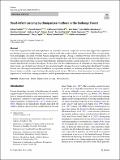Dead-infant carrying by chimpanzee mothers in the Budongo Forest
Abstract
It has been suggested that non-human primates can respond to deceased conspecifics in ways that suggest they experience psychological states not unlike humans, some of which could indicate they exhibit a notion of death. Here, we report long-term demographic data from two East African chimpanzee groups. During a combined 40-year observation period, we recorded 191 births of which 68 died in infancy, mostly within the first year. We documented the post-mortem behaviour of the mothers and describe nine occasions where Budongo chimpanzee mothers carried infants for 1–3 days after their death, usually until the body started to decompose. We also observed three additional cases of extended carrying lasting for more than 2 weeks, one of which was followed by the unusual extended carrying of an object and another which lasted 3 months. In each case, the corpses mummified. In addition, we report four instances of recurring dead-infant carrying by mothers, three of whom carried the corpse for longer during the second instance. We discuss these observations in view of functional hypotheses of dead-infant carrying in primates and the potential proximate mechanisms involved in this behaviour.
Citation
Soldati , A , Fedurek , P , Crockford , C , Adue , S , Akankwasa , J W , Asiimwe , C , Asua , J , Atayo , G , Chandia , B , Freymann , E , Fryns , C , Muhumaza , G , Taylor , D , Zuberbühler , K & Hobaiter , C 2022 , ' Dead-infant carrying by chimpanzee mothers in the Budongo Forest ' , Primates , vol. First Online . https://doi.org/10.1007/s10329-022-00999-x
Publication
Primates
Status
Peer reviewed
ISSN
0032-8332Type
Journal article
Description
A.S.’s fieldwork was supported by the European Research Council project grant to C.C. (grant agreement number 679787). C.H. is supported by funding from the European Union’s 8th Framework Programme, Horizon 2020 (grant agreement number 802719).Collections
Items in the St Andrews Research Repository are protected by copyright, with all rights reserved, unless otherwise indicated.

